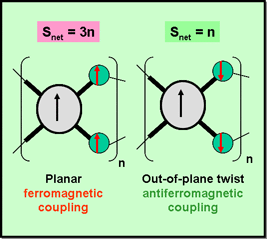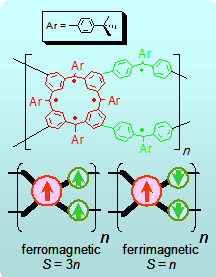How to achieve very large S and magnetic ordering?
- Must have very large number of spin sites ⇔ polymer
- Must defeat the defects ⇔ multiple exchange coupling pathways ⇔ polymacrocycle
- Must increase dimensionality ⇔ network polymer
To test these requirements, we set out to prepare a polymer network of macrocycles. We realized that out-of-plane twisting was likely to occur in this system, reversing the sign of exchange coupling from ferromagnetic to antiferromagnetic. To compensate for this effect, we designed the polymer network with ferrimagnetic coupling scheme: cross-linking between the macrocyclic modules with much larger S value and the linker module with much smaller S. This would ensure a large netS value.

We selected tetra-functionalized calix[4]arene as the macrocylic modules and the bis(biphenylene)methyls as the linker modules. This would would provide the polymer network with alternating unequal spins of S = 2 and S = 1/2.

- A. Rajca, S. Rajca, J. Wongsriratanakul, "Very High-Spin Organic Polymer: π-Conjugated Hydrocarbon Network with Average Spin of S ≥ 40", J. Am. Chem. Soc., 1999, 121, 6308.
- A. Rajca, J. Wongsriratanakul, S. Rajca, "Magnetic Ordering in an Organic Polymer", Science, 2001, 294, 1503.
In the synthesis of the polyether network (precursor to the polyradical network), there were two main fractions of product: soluble and insoluble polyethers. The soluble product was not too difficult to handle, and we reported the polymer network, a paramagnet with S ≥40 in 1999 (JACS, Communication). However, it took us two more years to improve the polymer synthesis and to figure out generation of the polyradical network, which led to the most exciting result, organic polymer with magnetic ordering, reported in Science magazine in November of 2001. This result attracted great public attention, particularly on the WWW (links).
Many may wonder how did we solve the problem with generation of polyradical from the insoluble polyether network?
... more coming soon!
|

